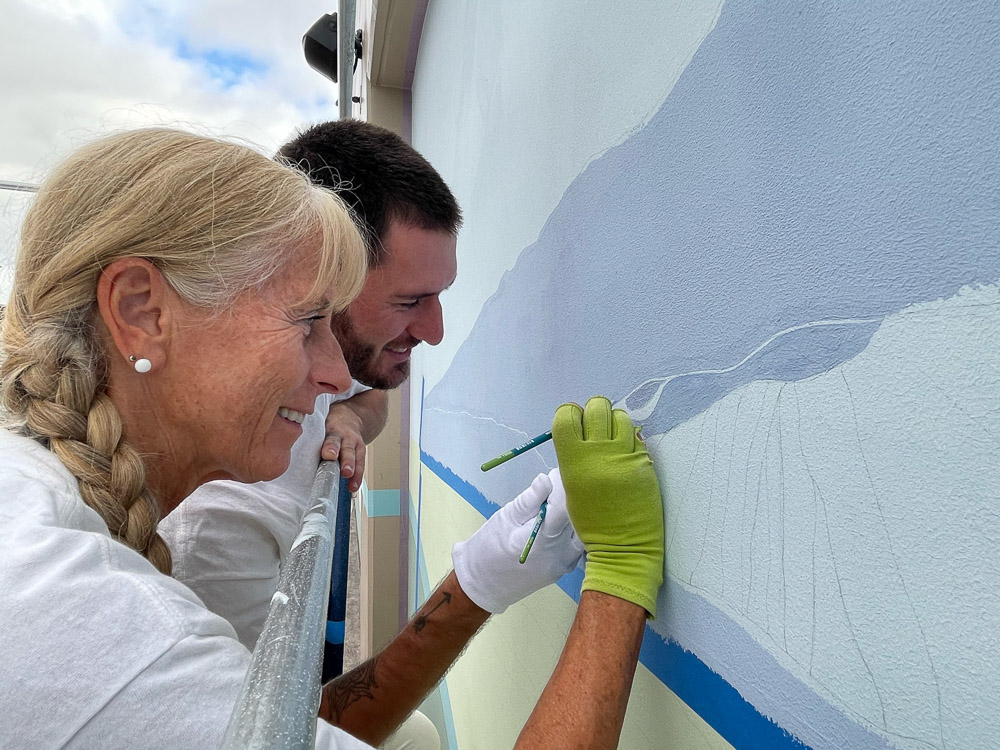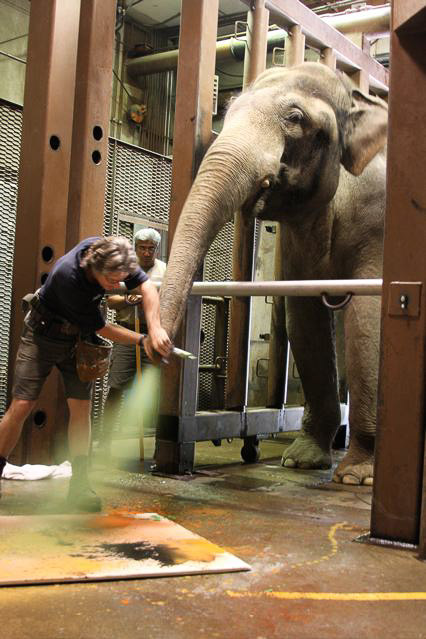

Calley O'Neil

O n the Kona side, Calley and Noa and their intrepid crew are working from 1 p.m. until after after dark in the Kona heat. As you pass by the TSA entry, you’ll see them in their white Mālama Hawai‘i t-shirts, rolling out miles of blue painters’ tape, and painting the background layers with 100-year mineral paint. They project the giant images on the walls, then painstakingly trace them on the concrete. This is where the handcrafted stained glass mosaic pieces will go, 21,000 of them, presently being cut by Calley’s 30-year stained glass partner, Lamar Yoakum.
Before she came to Hawai‘i, Calley’s art journey took her many places. She has a Bachelor of Fine Arts degree, summa cum laude, from Pratt Institute in New York, and a Masters in Social Ecology from Goddard College in Vermont. She has worked in the “field” of ecological fine art landscape design since the 70s, producing community green spaces and private gardens; and was among the first to use the term “edible landscape.”

For five years, she worked in partnership with Rama, an elephant in the Oregon Zoo. Using his trunk, Rama would lay down colorful background washes to which Calley added endangered species in the foreground and ecological details. This inter-species collaboration produced 22 paintings thus far, which made their debut at IUCN World Conservation Congress in 2016. From there, Calley was invited to display The Rama Exhibition: A Journey of Art and Soul for the Earth, at NOAA’S Mokupāpapa Discovery Center in Hilo, to raise awareness and seek help for earth’s endangered species and ecosystems. www.TheRamaExhibition.org
A busy professional artist, Calley also teaches yoga, art, and yoga-art fusions. She has been making public art for a long time, using the larger-than-life platforms to raise awareness and inspire change. Her works can be found at the Campus Center at University of Hawai‘i at Mānoa, Sensei Lānaʻi, a Four Seasons Resort, Kings’ Shops, Kīpapa Elementary School on O‘ahu, Puakea Bay Ranch, the Mālama Pono Center, Hawai‘i Maritime Center, Annunciation Church in Waimea, Pukalani School on Maui, and many others.
About three years ago, she received the airport commission from the Hawai‘i State Foundation for Culture and the Arts. Immediately she began her internal process, conceptualizing a work that would last at least 50 years, and would be viewed by 3–4 million people annually. A long series of meetings and consultations took place; ideas were considered and reconsidered, until the committee decided.

"They said, ‘We want the spirit of aloha,’” says Calley. “And I thought, What is the essence of aloha? How do I invoke an experience of aloha? What is Alo-Hā, connection to the breath, atmosphere? They said, ‘We want to feel it, we want to smell it.’” How to do that in a work of art, even a giant one, is not an easy task. Calley went first to source, the island’s elders, kūpuna, for their mana‘o (thoughts). And those thoughts were of aloha for the land and the waters, and their fears for its losses to depletion, deforestation, climate change, and more.
“These are lineal descendants of the land, wisdom carriers, and guardians,” she says. “They were kind enough, brave enough—with the ‘āina (land) in dire need—to say that the action of aloha is mālama, to take care of the land, and that is what’s missing in the Western dominant culture. They told me, ‘Show them the beauty of what was, what can be and must be again. We are all nourished by the land. We eat it, drink it, breathe it.’”
“Their wisdom is what I’m seeking to capture,” she says. “I asked all of them, ‘What is the most important thing you want to say to a million people every year?’ and they all said exactly the same thing. ‘Mālama ‘āina.’” The resulting “E Ola Ka Honua!” mural concept is for eight walls to express eight perspectives on mālama ‘āina, featuring huge portraits of some of the island’s most esteemed kūpuna and their families.
“They are so humble; it’s not like they really want to be portrayed in monumental scale on a wall. They would much rather live quietly in harmony and with their land and water.” One of the kūpuna (elders) she invited wanted to be a small smudge of paint on the landscape. “I said, ‘OK, you can be, but people will walk right by, and it won’t grab their attention. But if you are 8-10’ tall, pouring water from one generation to the next, people will stop.’ So kūpuna are not just guiding the mural, they are in the mural.”

The completed walls of E Ola Ka Honua! will portray the following elements, represented by cultural experts, master artisans, voyagers, ocean and land protectors, and storytellers -- past and present. An online search for these names may take the reader on a journey of their own.
- ALOHA: Kumu Keala Ching and Earl Regidor
- THE LIVING WATERS: Hannah Springer and son, Kekaulike Tomich
- THE OCEAN: The late Ling Nakachi, son MIke, and his children Kaikea and Alohi
- THE NATIVE FORESTS: Yvonne Carter, Keoki Carter and lead students Wilds and Lehua
- VOYAGING: Chadd Paishon, Pomai Bertelmann, Shorty Bertelmann, the late Clay Bertelmann, and the late Master Navigator Papa Mau Pialug
- THE CULTURE: Ku‘ulei Keakealani, her daughters Kamehanamauloa, Ku‘unahenani and Kahaka‘ioikamala‘e, and Ku‘ulei's dad, Sonny Keakalani
- TRADITIONAL FOODS & CULTIVATION: Ruth Aloua, the late Clayton Punihaole, and the late Clement Kanuha, Jr.
- ALOHA & FUTURE GENERATIONS: Reggie Lee, grandson Haʻa, Reggie’s mother and master weaver, the late Auntie Maluihi Elizabeth Lee
Our job is to stand behind indigenous wisdom. I want people to feel their wisdom and think ‘Yes, this is Hawai’i.’
“Our job is to stand behind indigenous wisdom. I want people to feel their wisdom and think ‘Yes, this is Hawai’i.’ People coming here are coming here for this spirit. And if you ask the kūpuna and those kūpuna that have passed for help, guidance, ask permission, and give thanks, they will help you. One of the kūpuna said, ‘You didn’t even have to tell us you were doing this.’ But what right would I have to express my personal trip at the airport? No, no, no.”
Calley’s work has already exceeded expectations and boundaries; she is doing extensive fundraising on her own to continue as the mural concept expands. One way to help is to donate to the Thin Blue Line project. From space, the earth’s atmosphere is seen as a thin blue line, a thin delicate membrane that contains all life. A thin blue line will run the entire length of the mural, made of blue glass tiles that the team is handcrafting from sake bottles. The plaques will bear family names and their water sources and uplifting quotes. Learn more at www.calleyoneill.com
Art, to Calley, needs to be transformational. It needs to inspire growth and change and express something bigger than oneself. Her art journey has brought her to this place, and this giant space, to fill with the awakening messages of mālama ‘āina. In this, like many of her experiences along the way, Calley thinks of herself first and foremost as an activist. “I’m somebody who acts, rather than complains,” she says. “I have often told my children, ‘Every day that I am alive I am going to act. Then you will know, Mama has done her best.’”
Journeys within journeys within journeys. What the finished airport projects looks like, feel like, and sound like, remains to be experienced. One thing we know, they will be as unique, unexpected and as fiercely inspiring as our Hawai‘i Island.
For more information:
Calleyoneill.com
KFK.art